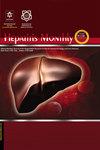Identification of a 17-gene-signature in Non-alcoholic Steatohepatitis and Its Relationship with Immune Cell Infiltration
IF 0.6
4区 医学
Q4 GASTROENTEROLOGY & HEPATOLOGY
引用次数: 0
Abstract
Background: Non-alcoholic steatohepatitis (NASH) is a risk factor for hepatocellular carcinoma, but the understanding of the regulatory mechanisms driving NASH is not comprehensive. Objectives: We aimed to identify the potential markers of NASH and explore their relationship with immune cell populations. Methods: Five gene expression datasets for NASH were downloaded from the Gene Expression Omnibus and European Bioinformatics Institute (EBI) Array Express databases. Differentially expressed genes (DEGs) between NASH and controls were screened. Gene Ontology-Biological Process (GO-BP) and Kyoto Encyclopedia of Genes and Genomes (KEGG) enrichment analyses were performed for functional enrichment analysis of DEGs. Among the candidate genes selected from the protein-protein interaction (PPI) network and module analysis, DEG signatures were further identified using least absolute shrinkage and selection operator (LASSO) regression analysis. The Spearman correlation coefficient was calculated to assess the correlation between DEG signatures and immune cell abundance based on the CIBERSORT algorithm. Results: We screened 403 upregulated, and 158 downregulated DEGs for NASH, and they were mainly enriched in GO-BP, including the inflammatory response, innate immune response, signal transduction, and KEGG pathways, such as the pathways involved in cancer (e.g., the PI3K-Akt signaling pathway), and focal adhesion. We then screened 73 candidate genes from the PPI network and module analysis and finally identified 17 DEG signatures. By evaluating their relationship with immune cell populations, 12 DEG signatures were found to correlate with activated dendritic cells, resting dendritic cells, M2 macrophages, monocytes, neutrophils, and resting memory CD4 T cells, which were significantly different between the NASH and control tissues. Conclusions: We identified a 17-DEG-signature as a candidate biomarker for NASH and analyzed its relationship with immune infiltration in NASH.非酒精性脂肪性肝炎17基因特征的鉴定及其与免疫细胞浸润的关系
背景:非酒精性脂肪性肝炎(NASH)是肝细胞癌的危险因素,但对驱动NASH的调节机制的理解并不全面。目的:我们旨在鉴定NASH的潜在标志物,并探讨它们与免疫细胞群的关系。方法:从基因表达综合数据库和欧洲生物信息学研究所(EBI)Array Express数据库下载5个NASH基因表达数据集。筛选NASH和对照组之间的差异表达基因(DEG)。对DEG的功能富集分析进行了基因本体论生物过程(GO-BP)和京都基因和基因组百科全书(KEGG)富集分析。在从蛋白质-蛋白质相互作用(PPI)网络和模块分析中选择的候选基因中,使用最小绝对收缩和选择算子(LASSO)回归分析进一步鉴定了DEG特征。基于CIBERSORT算法计算Spearman相关系数以评估DEG特征与免疫细胞丰度之间的相关性。结果:我们筛选出403个NASH上调DEG和158个NASH下调DEG,它们主要富集于GO-BP,包括炎症反应、先天免疫反应、信号转导和KEGG途径,如参与癌症的途径(如PI3K-Akt信号途径)和局灶性粘附。然后,我们从PPI网络和模块分析中筛选出73个候选基因,最终鉴定出17个DEG特征。通过评估它们与免疫细胞群的关系,发现12个DEG特征与活化的树突细胞、静息树突细胞、M2巨噬细胞、单核细胞、中性粒细胞和静息记忆CD4 T细胞相关,这在NASH和对照组织之间有显著差异。结论:我们确定了17 DEG信号作为NASH的候选生物标志物,并分析了其与NASH免疫浸润的关系。
本文章由计算机程序翻译,如有差异,请以英文原文为准。
求助全文
约1分钟内获得全文
求助全文
来源期刊

Hepatitis Monthly
医学-胃肠肝病学
CiteScore
1.50
自引率
0.00%
发文量
31
审稿时长
3 months
期刊介绍:
Hepatitis Monthly is a clinical journal which is informative to all practitioners like gastroenterologists, hepatologists and infectious disease specialists and internists. This authoritative clinical journal was founded by Professor Seyed-Moayed Alavian in 2002. The Journal context is devoted to the particular compilation of the latest worldwide and interdisciplinary approach and findings including original manuscripts, meta-analyses and reviews, health economic papers, debates and consensus statements of the clinical relevance of hepatological field especially liver diseases. In addition, consensus evidential reports not only highlight the new observations, original research, and results accompanied by innovative treatments and all the other relevant topics but also include highlighting disease mechanisms or important clinical observations and letters on articles published in the journal.
 求助内容:
求助内容: 应助结果提醒方式:
应助结果提醒方式:


